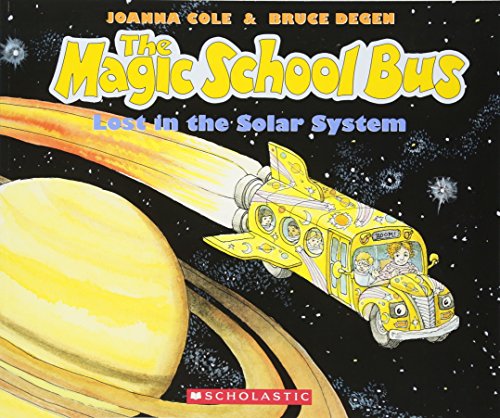On this page: General Resources | Sun | Moon | Planets | Flying Objects | Experiments
general resources
📖 The Magic School Bus Lost in the Solar System by Joanna Cole. The kids get a close-up look at the solar system when their school bus turns into a space ship. Here is a fun and memorable introduction to the topic. – Preschool • Elementary
📖 Our Solar System by Seymour Simon. The Smithsonian has published a series of excellent space-themed books by Seymour Simon. Each title features loads of scientific information and huge, gorgeous images. Our Solar System introduces the planets, sun, moon, asteroids and meteors. – Elementary • Middle
📖 The Planet Gods: Myths & Facts About the Solar System by Jacqueline Mitton. The planets, the sun, and the moon all tell their stories in this lavishly illustrated book. It’s more poetic than informational, but can be a worthy supplement to any study of the planets or the Greek pantheon. – Elementary
🔗 Content Connection: Universe. Check out the General Resources to find more good books and videos about space.
🔗 Content Connection: Space Travel. Learn about US explorations into space.
▶️ The solar system – our home in space from Kurzgesagt. “The Solar System is where we live. We share it with seven other planets, orbiting our sun, which will eventually die. What makes this place special, and what are the other worlds in our solar system like?”
✏️ Gravity and Orbs from PhET. Try this fun online simulation from PhET: “Move the sun, earth, moon and space station to see how it affects their gravitational forces and orbital paths. Visualize the sizes and distances between different heavenly bodies, and turn off gravity to see what would happen without it!” – All
sun
📖 Sun! One in a Billion by Stacy McAnulty. This entry in the “Our Universe” series offers a cute, humorous introduction to the Sun, as told by the very self-important Sun himself. Endnotes give more information. Also see the other books in the series: Earth! and Moon! – Elementary
▶️ The Sun’s surprising movement across the sky from TED-Ed. “Suppose you placed a camera at a fixed position, took a picture of the sky at the same time every day for an entire year, and overlaid all of the photos on top of each other. What would the sun look like in that combined image? A stationary dot? A circular path? Neither. Oddly enough, it makes a ‘figure 8’ pattern, known as the Sun’s analemma.” – Middle • High
▶️ Sunlight is older than you think from TED-Ed. “It takes light a zippy 8 minutes to reach Earth from the surface of the Sun. But how long does it take that same light to travel from the Sun’s core to its surface? Oddly enough, the answer is many thousands of years. Sten Odenwald explains why by illustrating the random walk problem.” – All
▶️ A rare, spectacular total eclipse of the sun from TED-Ed. “How can the tiny moon eclipse the sight of the gargantuan sun? By sheer coincidence, the disc of the sun is 400x larger than the disc of the moon, but the sun is 390x farther from Earth, which means that when they align just right, the moon blocks all but the sun's glowing corona.” – All
▶️ Could solar storms destroy civilization? from Kurzgesagt. The sun. Smooth and round and peaceful. Except when it suddenly vomits radiation and plasma in random directions. These solar flares can hit earth and have serious consequences for humanity. – Middle • High
moon
📖 Moon! Earth’s Best Friend by Stacy McAnulty. In this funny and informative “Our Universe” book, we learn about the formation and importance of the moon from Earth’s self-appointed best friend, the moon itself. Also check out the other books in the series: Earth! and Sun! – Elementary
📖 The Moon Seems to Change by Franklyn Branley. “Have you noticed that the moon sometimes seems to grow and shrink? Read and find out about the phases of the moon! With a simple experiment using an orange, a pencil, and a flashlight, you can see for yourself why the moon looks different at different times of the month.” – Preschool • Elementary
📖 What the Moon Is Like by Franklyn Branley. In What the Moon is Like, Branley explains what it would be like to stand on the moon. More information and activity ideas can be found in the endnotes. – Preschool • Elementary
▶️ Tidal locking from MinuteEarth. "Why do we only see one side of the moon?" – All
▶️ Tour of the moon from NASA Goddard. "Although the moon has remained largely unchanged during human history, our understanding of it and how it has evolved over time has evolved dramatically . . . See some of the sights and learn more about the moon here!"– All
planets
📖 The Planets in Our Solar System by Franklyn Branley. The recently updated Planets gives a little information on each of the eight planets. The end section includes additional information and activity suggestions. – Preschool • Elementary
📖 Pluto’s Secret: An Icy World’s Tale of Discovery by Margaret Weitekamp. This wonderful picture book tells of Pluto’s discovery and its re-classification from planet to Kuiper Belt Object. Highly recommended, especially for kids who are outraged to learn that Pluto is no longer considered a planet. – Elementary
🔗 Content Connection: Geology. Explore Earth’s history.
▶️ The journey to Pluto, the farthest world ever explored from TED-Ed. “As of 1989, mankind had successfully sent craft to every known planet in the solar system except one: Pluto. Located in an mysterious region called the Kuiper Belt, Pluto is a scientific goldmine, and could hold clues to the formation of our solar system.” – All
flying objects
📖 Impact! Asteroids and the Science of Saving the World by Elizabeth Rusch. This information-dense title in the Scientists in the Field series dives into the science of asteroids: “Follow [Rusch] into the field with scientists as they search for dangerous asteroids in space, study asteroids that have smashed into the ground, and make plans to prevent an asteroid strike if one ever threatens our planet.” – Elementary • Middle
▶️ The first asteroid ever discovered from TED-Ed. “Over the course of history, we’ve discovered hundreds of thousands of asteroids. But how do astronomers discover these bits of rock and metal? How many have they found? And how do they tell asteroids apart? Carrie Nugent shares the story of the very first asteroid ever discovered and explains how asteroid hunters search for these celestial bodies.” – All
experiments
🖐️ Explore Earth's place in space. Unit I of Janice Van Cleave’s Earth Science for Every Kid has experiments that help illuminate common phenomena, such as night & day and eclipses. – Elementary
🖐️ Make a sundial. Explore the movement of the sun across the sky with simple materials (pencil, tape, paper plate) in the “Pencil Sundial” experiment in Crystal Chatterton’s Awesome Science Experiments for Kids. – Elementary
🖐️ Participate in Citizen Science. Search the SciStarter database to find projects appropriate for your child’s age. Most Astronomy-focused projects are conducted online and include helping to map the surface of Mars, searching online NASA data for new comets, searching for Planet 9, and accessing data to help predict solar storms. – All

















